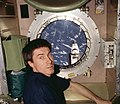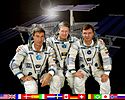ISS Ekspedition 1
| ISS Ekspedition 1 | |
|---|---|
 Besætningen på ISS Ekspedition 1: Krikalev, Shepherd, Gidzenko | |
| Missionen | |
| Fartøjets navn | ISS |
| Mission | Ekspedition 1 |
| Besætning | 3 |
| Opsendelse | 31. oktober 2000 |
| Opsendt med | Sojuz TM-31 |
| Landing | 21. marts 2001 |
| Landingsfartøj | Discovery STS-102 |
| Missionens varighed | 140 dage 23 timer |
| Rumvandringer | |
| EVA i alt | Ingen rumvandringer |
| Foto af besætningen | |
 Besætningen på ISS Ekspedition 1: Krikalev, Shepherd, Gidzenko | |
| Navigation | |
ISS Ekspedition 1 var den første tur med en besætning, der skulle bo i længere tid på Den Internationale Rumstation (ISS). Rumstationen modtog sine første beboere d. 2. november 2000. Besætningen blev opsendt d. 31. oktober 2000 i rumskibet Sojuz TM-31 fra Baikonur i Kasaksthan. Den fire måneder lange tur om bord på ISS blev afsluttet med frakobling d. 18. marts 2001 og retur på rumfærgen Discovery 21. marts 2001.
Missionen
Efter opsendelsen var Sojuz TM-31 i en midlertidig bane, og piloten Jurij Gidzenko kunne begynde en serie manøvrer, som skulle lede Sojuz-rumskibet nærmere ISS. Tilkoblingen med Zvezda-modulet skete 2. november. Efter sammenkoblingen åbnede astronauten William Shepherd lugen til Zvezda-modulet, og besætningen gik om bord på rumstationen for første gang.
Besætningens første opgaver var aktiveringen af "kabyssen" i Zvezda-modulet, montering af sovepladser, og indledende kommunikationscheck med både kontrolcentrene i Moskva og Houston. Besætningen brugte russisk kommunikationsudstyr fra Zvezda-modulet og Zarja-modulet og amerikansk udstyr fra Unity-modulet.
De første uger om bord brugte besætningen tiden til at aktivere kritiske livsstøtte-systemer og pakkede komponenter ud til rumstationen: beklædning, computere, kontorudstyr, kabler og elektrisk udstyr leveret af tidligere rumfærger gennem de 2 sidste år.
Besætningen deltog også i monteringen af nye moduler til rumstationen, inklusive Destiny-modulet. Den gennemførte også flere videnskabelige eksperimenter.[1] Under sine fire måneder om bord havde besætningen besøg af tre rumfærger, som medbragte nye moduler/komponenter til rumstationen. Ud over at bidrage med monteringen af disse måtte besætningen også tømme nyttelast fra to besøgende Progress forsyningsfartøjer. Under ekspedition 1 blev rumstationen udvidet med følgende moduler/komponenter:
- P6 truss segment af solcellepanel.
- Det amerikanske videnskabelige laboratorium Destiny.
Missioner i forbindelse med ekspeditionen
- Sojuz TM-31, opsendelse af ISS Ekspedition 1
- STS-97, montering af P6 truss segment af solcellepanel.
- STS-98, montering af Destiny-modulet
- STS-102, landing for ISS Ekspedition 1, ISS Ekspedition 2 ankommer
Besætning
 William Shepherd
William Shepherd  , ISS kaptajn (NASA)
, ISS kaptajn (NASA) Sergej Krikaljov
Sergej Krikaljov  , flymaskinist (RKA)
, flymaskinist (RKA) Jurij Gidzenko
Jurij Gidzenko  , Sojuz-pilot (RKA)
, Sojuz-pilot (RKA)
Reservebesætningen var ISS Ekspedition 3
Se også
- Den Internationale Rumstation
- Besøgende til den Internationale Rumstation
- Bemandede rumflyvninger
- Sojuz-programmet
Eksterne henvisninger
- Expedition One Crew Arkiveret 29. april 2008 hos Wayback Machine NASA
- Ekspedition 1 galleri Arkiveret 27. april 2008 hos Wayback Machine NASA
- ^ Videnskabelige eksperimenter Ekspedition 1 Arkiveret 4. maj 2008 hos Wayback Machine NASA
Medier brugt på denne side
Forfatter/Opretter: Kwamikagami, Licens: CC BY-SA 4.0
symbol of Mars. 16 × 16 pixel nominal dimensions, lines 2 pixel thick, square caps. Colour 75% blue: red=0 green=0 blue=191 (#0000BF).
Crew of ISS Expedition 1 launched with Soyuz TM-31
ISS Expedition One Commander William M. (Bill) Shepherd (center) is flanked by Soyuz Commander Yuri P. Gidzenko (right) and Flight Engineer Sergei K. Krikalev (left) in this crew photograph, taken during a break in training in Russia. The three, posed in front of a rendition of the International Space Station, are wearing the Sokol space suits like those they will don for their Soyuz-provided trip to ISS later this month. National flags representing all the international partners run along the bottom of the portrait.
- Destiny ISS module taken by STS-108 (NASA)
- original description: As seen in a medium view from a digital still camera aimed through a window on Endeavour's aft flight deck, the International Space Station (ISS), now staffed with its fourth three-person crew, is contrasted against a patch of the blue and white Earth during a farewell look from the shuttle following undocking. The Destiny laboratory is partially covered with shadows in the foreground (15 December 2001).
A Progress supply ship linked up to the orbiting International Space Station (ISS) at 3:48 GMT, November 18, bringing Expedition One commander William M. Shepherd, pilot Yuri P. Gidzenko and flight engineer Sergei K. Krikalev two tons of food, clothing, hardware and holiday gifts from their families. The photograph was taken with a 35mm camera and the film was later handed over to the STS-97 crew members for return to Earth and subsequent processing.
The first International Space Station crew patch is a simplified graphic of the station complex when fully completed. The station is seen with solar arrays turned forward. The last names of the Expedition One crew, Soyuz pilot Yuri Gidzenko, flight engineer Sergei Krikalev, and expedition commander William (Bill) Shepherd, appear under the station symbol.
The International Space Station as seen from the departing Space Shuttle Atlantis on STS-106 following the arrival of the Russian Zvezda Service Module to the orbital complex. In view from top to bottom are the Unity Module, the Zarya FGB, the Zvezda SM and the docked Progress M1-3 spacecraft. During the course of the mission, the STS-106 crew readied the station for permanent occupation by outfitting it in preparation for the arrival of its first residents, the three-man Expedition 1 crew, launched aboard Soyuz TM-31 on 31 October 2000.
Cosmonaut Sergei K. Krikalev, flight engineer for Expedition One, is positioned at a port hole on the Zvezda service module of the International Space Station












